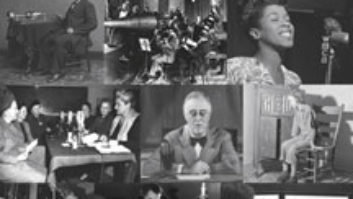Founded in the late 1970s by saxophonist Dan Kuramoto, Hiroshima has had a long and successful career, and the band’s 11 albums have sold more than 3 million copies. Currently promoting their latest CD on Heads Up Records, Between Black and White, Hiroshima recently came to Yoshi’s, one of the San Francisco Bay Area’s top jazz venues, for a four-night stand. Mix met with band sound engineer John McCourt and Yoshi’s resident engineer, Dan Pettit, before the final show.
HOUSE MICS MEET EXPECTATIONS
Hiroshima does not typically carry sound equipment, so McCourt relies on whatever system the house provides. “It makes it challenging for me, but I enjoy it,” he comments. “I see the job of the soundman as someone who goes in and does the best he can. You make it sound as good as you can with what you have to work with. I have certain standards — we send out a rider — and most of the time, I get what I want.”
The house P.A. is made up of a flown center cluster of three Meyer Sound CQ2s supplemented by a CQ1 and a PSW-2 subwoofer flown on each side. Frontfill for the handful of audience members seated at the very lip of the stage is provided by four Meyer HM1s. Onstage monitors are Meyer PSM models, which, like all of the other Meyer speakers, are self-powered and contain onboard processing and limiting.
With eight bandmembers, four vocal mics and a full drum setup, Hiroshima requires many more mics than traditional jazz acts that make up the bulk of Yoshi’s bookings. “I like to use 98s or 57s for the toms,” says McCourt. “They’ve got to have my kick drum mic, too. I like a 421, I like a B52 and I like a 91 — not the Beta 91, the regular SM91. If you’ve got one of those three for me, I’m fine with it. And, as long as they have some good condensers for overheads, I’m fine with that. Here [at Yoshi’s], he’s got great overhead mics — they’re Neumann KM84s. They have a real nice mic selection.”
McCourt typically uses about 28 inputs, which leaves him plenty of room on the 40-channel Crest X8. The 24/12 Spirit Monitor board easily generates the needed eight monitor mixes, which are distributed onstage through nine wedges. The band rarely uses sidefills, even on wide festival stages.
The Hiroshima stage plot includes two electronic keyboard positions, one at center stage for Kimo Cornwell and another at stage left for Dan Kuramoto, who also plays saxophone. At the back of the stage, drummer Danny Yamamoto is flanked by electric guitarist Fred Shreuders and Dean Cortez on electric bass, while vocalist Terry Steele works stage center and June Kuramoto sits with her koto downstage right.
“It’s not like miking a rock band — there’s a few nuances to cover,” notes McCourt. For the zither-like koto, an acoustic instrument that sits on the floor, McCourt uses a two-pronged approach: A Barcus-Berry pickup inside the instrument runs into a DI and from there into a Conn strobotuner, which June Kuramoto uses to tune between numbers. McCourt uses some of the Barcus-Berry signal to add brightness, but mainly relies on a Shure SM91 in the koto’s sound hole.
McCourt has tried a wide variety of mics on Dan Kuramoto’s various woodwinds, including Beyer wireless mics and Shure SM98s. “I’ve now found a really good mic I just love,” he enthuses. “SD Systems makes mics specifically for horns, so now I carry one of them. On the shakahachi, I use a real long reverb — about nine seconds, with a 100ms predelay,” notes McCourt. Because he can usually achieve this effect on any modern digital reverb, McCourt is usually satisfied with whatever reverb units the house supplies.
As far as levels go, Pettit can advise but not insist. “It’s in the bands’ contracts that they have control of the production. So as a venue, we don’t have a lot of say in the volume level,” he says. “We try to keep it at a comfortable level, and most bands adhere to that.”

